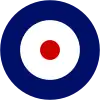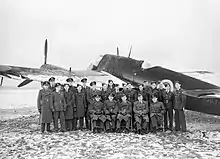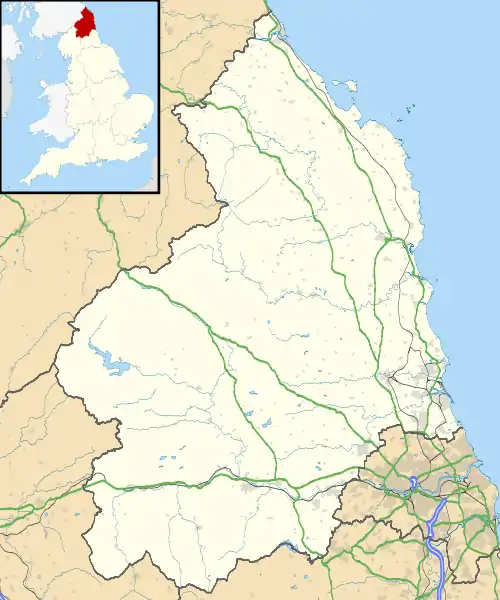RAF Acklington
Royal Air Force Acklington, simply known as RAF Acklington, is a former Royal Flying Corps and Royal Air Force station located 3.2 miles (5.1 km) south west of Amble, Northumberland and 8.8 miles (14.2 km) north east of Morpeth, Northumberland.
RAF Acklington RAF Southfields RFC Southfields  | |||||||||||||||||||
|---|---|---|---|---|---|---|---|---|---|---|---|---|---|---|---|---|---|---|---|
 'B' flight, No. 409 Sqn RCAF with one of their Bristol Beaufighters in January 1942. | |||||||||||||||||||
| Summary | |||||||||||||||||||
| Airport type | Military | ||||||||||||||||||
| Owner | Ministry of Defence | ||||||||||||||||||
| Operator | Royal Flying Corps Royal Air Force | ||||||||||||||||||
| Location | Acklington, Northumberland | ||||||||||||||||||
| Built | 1916 | ||||||||||||||||||
| In use | 1916–1920 1938–1975 | ||||||||||||||||||
| Elevation AMSL | 95 ft / 29 m | ||||||||||||||||||
| Coordinates | 55°17′46″N 001°38′04″W | ||||||||||||||||||
| Map | |||||||||||||||||||
 RAF Acklington Location in Northumberland | |||||||||||||||||||
| Runways | |||||||||||||||||||
| |||||||||||||||||||
The airfield was operational initially from 1916 being used by the Royal Flying Corps (RFC) and from April 1918 its successor the Royal Air Force (RAF) before being closed in 1920 however it was reopened in 1938 being used by the RAF until 1972. After 1972 the site was turned over to Her Majesty's Prison Service for the creation of two new prisons.
History
First World War
Acklington was an aerodrome during the First World War and known as Royal Flying Corps Station Southfields.[2]
Second World War
The airfield was reopened on Friday 1 April 1938 being renamed to RAF Acklington where No. 7 Armament Training Station was formed which on 15 November 1938 transformed into No. 2 Air Observers School. During September 1939 the school moved to RAF Warmwell and the airfield was handed over to RAF Fighter Command as part of 13 Group where it became a sector airfield.[3]
The following squadrons were at some point posted or attached to RAF Acklington:[4]
On 3 February 1940 three Hawker Hurricane fighters from 43 Squadron at Acklington intercepted and shot down a Luftwaffe Heinkel He 111 bomber at Whitby. The formation was led by Flight Lieutenant Peter Townsend. It was the first German aircraft to fall on English soil in World War II (although it was not the first to be shot down in the United Kingdom, that having occurred in Scotland). The intercept was based on a plot by operators at RAF Danby Beacon, a radar station about ten miles west of Whitby. Townsend visited the German rear gunner in hospital the next day, and visited him again in 1968 when Townsend was writing his highly-successful book about the Battle of Britain, "Duel of Eagles," which recounts the incident in detail.[5]
On 21 October 1942 well known test pilot Gerry Sayer departed from RAF Acklington in a Hawker Typhoon to test a gunsight during gun firing into Druridge Bay Ranges, and was accompanied by another Typhoon. Neither aircraft returned and it was assumed that they collided over the bay. Sayer was replaced as Gloster's chief test pilot by his deputy, Michael Daunt.
Battle of Britain
RAF Acklington was home to the following squadrons during the Battle of Britain:
- 72 Squadron between 6 June 1940 and 31 August 1940 with the Supermarine Spitfire Mk I before moving to RAF Biggin Hill.[6]
- 79 Squadron between 13 July 1940 and 27 August 1940 with the Hawker Hurricane Mk I before moving to RAF Biggin Hill.[7]
- 32 Squadron between 28 August 1940[8] and 15 December 1940 with the Hurricane Mk I before moving to RAF Middle Wallop.[9]
- 610 Squadron between 31 August 1940[10] and 15 December 1940 with the Spitfire Mk I before moving to RAF Westhampnett.[11]
October 1940–1945
The following squadrons were at some point posted or attached to RAF Acklington:[4]
Airfield units
The following units were at some point posted or attached to RAF Southfields/Acklington:[2]
- No. 1 Fighter Command Servicing Unit RAF
- No. 3 Aircraft Delivery Flight RAF
- No. 3 Tactical Exercise Unit RAF
- No. 4 Aircraft Delivery Flight RAF
- No. 6 Flying Training School RAF
- No. 13 Group Target Towing Flight RAF became No. 1490 (Target Towing) Flight RAF
- No. 24 (Base) Defence Wing RAF
- No. 59 Operational Training Unit RAF
- No. 147 Airfield
- 416th Night Fighter Squadron
- No. 1460 (Fighter) Flight RAF
- No. 1630 (Anti-Aircraft Co-operation) Flight RAF
- Fighter Armament Trials Unit RAF
- No. 2718 Squadron RAF Regiment
- No. 2738 Squadron RAF Regiment
- No. 2741 Squadron RAF Regiment
- No. 2765 Squadron RAF Regiment
- No. 2799 Squadron RAF Regiment
- No. 2800 Squadron RAF Regiment
- No. 2803 Squadron RAF Regiment
- No. 2820 Squadron RAF Regiment
Current use
RAF Acklington closed in 1975 and the main camp became the site of Acklington and Castington prisons.[2] These have since been amalgamated and transferred into private ownership and are simply known as H. M. P. Northumberland. The airfield is virtually unrecognisable today having been subjected to open cast coal mining.
References
Citations
- Delve 2006, p. 26
- "Acklington (Southfields)". Airfields of Britain Conservation Trust. Retrieved 11 December 2012.
- "RAF Acklington". The Wartime Memories Project. Archived from the original on 27 September 2012. Retrieved 11 December 2012.
- Jefford 1988, p. 153.
- Peter Townsend, Duel of Eagles, (New York, Simon and Schuster, 1970), pp 7-8.
- "Battle of Britain history of No. 72 Squadron". Royal Air Force. Retrieved 11 December 2012.
- "Battle of Britain history of No. 79 Squadron". Royal Air Force. Retrieved 11 December 2012.
- "Battle of Britain history of No. 32 Squadron". Royal Air Force. Retrieved 11 December 2012.
- Jefford 1988, p. 35.
- "Battle of Britain history of No. 610 Squadron". Royal Air Force. Retrieved 11 December 2012.
- Jefford 1988, p. 99.
Bibliography
- Delve, Ken (2006). The Military Airfields of Britain: Northern England: Co. Durham, Cumbria, Isle of Man, Lancashire, Merseyside, Manchester, Northumberland, Tyne & Wear, Yorkshire. Marlborough: The Crowood Press. ISBN 1-86126-809-2.CS1 maint: ref=harv (link)
- Jefford, C G (1988). RAF Squadrons. A comprehensive record of the movement and equipment of all RAF squadrons and their antecedents since 1912. Shrewsbury: Airlife. ISBN 1-85310-053-6.
- Stewart, Elizabeth (2002). RAF Acklington. Amble, Northumberland, UK: Amble Social History Group..
External links
| Wikimedia Commons has media related to RAF Acklington. |

